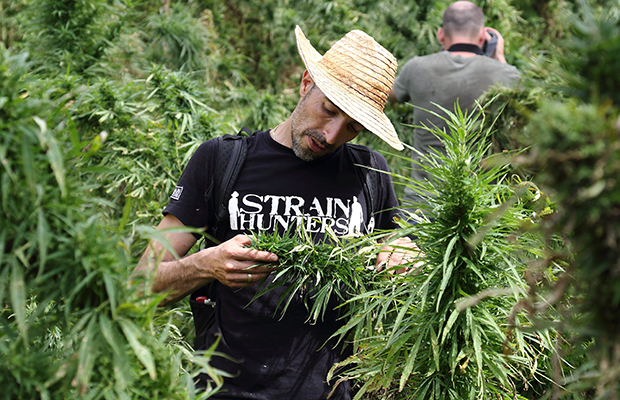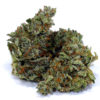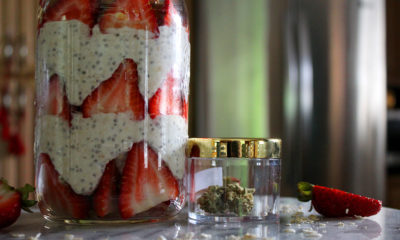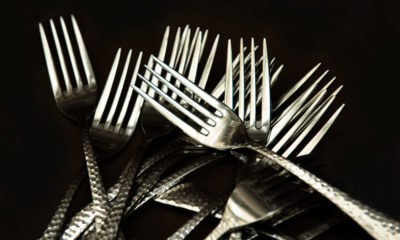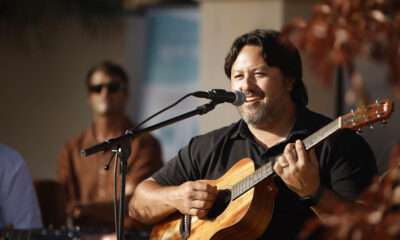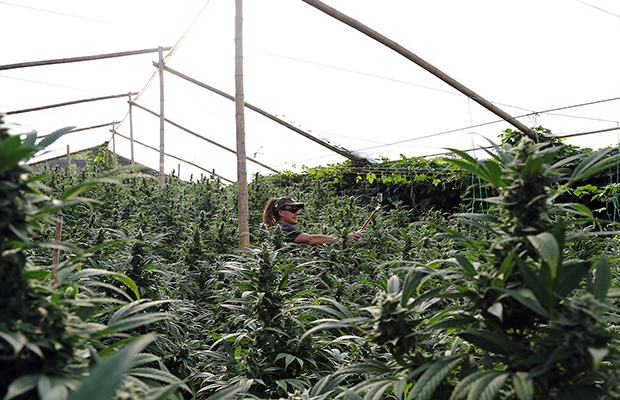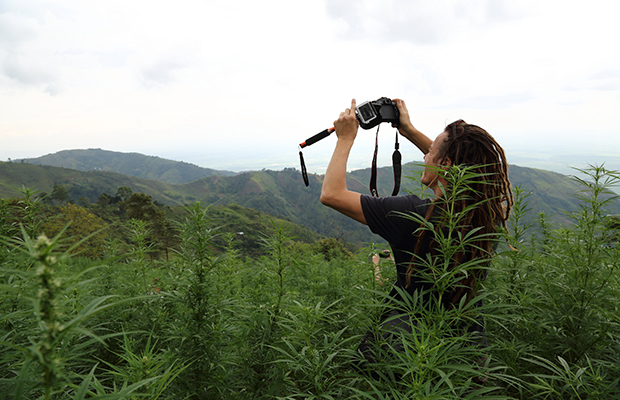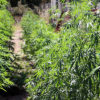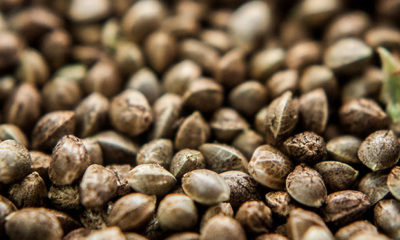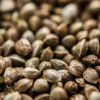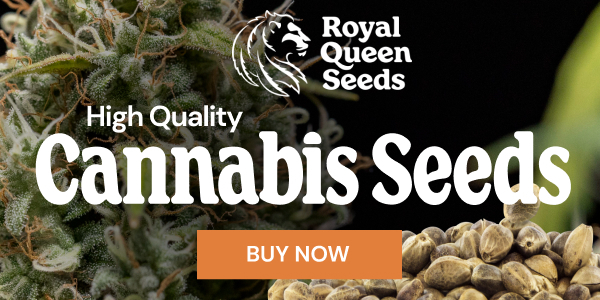Strain Hunters: Colombia – In Search of Punto Rojo, Colombian Gold & Limon Verde
Arjan Roskam has travelled deep into the FARC rebel-controlled territory of the Colombian jungles in the northwestern Amazon rainforest in search of three original South American landraces.
Inside a huge, steamy outdoor greenhouse, men delicately inspect each plant. It’s hot and sticky in the rainforest; they occasionally pause to wipe away beads of sweat. A soft breeze from the electronic fans provides some needed relief as they continue moving through the field, plant by plant. Despite the heat and the distant, infrequent gunshots shattering the tranquility inside the greenhouse, the men are happy to be there.
“The people who run this operation, they lost their fathers, their brothers… this gives you an idea of how rough the past was. Now, they are marijuana growers. That is the greatest thing on earth, they go from guerrillas to growing marijuana, what else do you want on this plant?” asks Arjan Roskam, founder of Green House Seed Company in Amsterdam and self-proclaimed “King of Pot”.
“With the original landrace material I can breed it, store it in my library, use it to make new genetics that win cannabis cups, that make people rich, that are going to put people in jail and are going to change people’s destinies,” Franco muses, “…and this is why I wake up with a smile every fucking day of my life.”
Seeking out these original landraces is risky business because they grow in some of the most war-torn and embattled countries on the face of the earth. Sativas, which are rarely found in a pure form, originated near the equator, and thrive in the high sun, heat and elevation in Colombia and other equatorial South American countries.
Upon arriving in Cali, Colombia’s third largest city, Arjan and Franco are brought by their tour guide, El Gato, to a large high-quality outdoor marijuana grow of Colombian Gold. Although Colombia has decriminalized cannabis (and cocaine, the country’s number one export), growing marijuana on an industrial scale remains illegal.
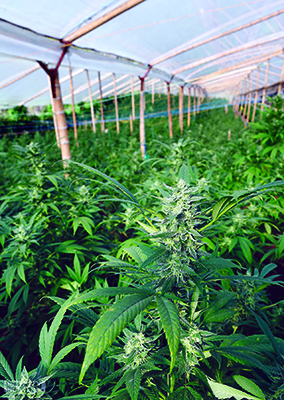
This grow, tended by former FARC guerrillas is high-tech and well-tended, white tarps diffuse the natural sunlight, black tarps are in position for light deprivation in the early summer, a perfect breeze is generated by fans to grow the stalks strong in order to support the weight of the buds that have begun to emerge. The plants are poured over daily, inspected for bugs or any sign of damage. This operation produces up to six tons a year of dried flowers.
Just a few years ago, traveling to this part of Colombia in search of landraces would have been far too dangerous; today there is still a clear and present danger in these parts of the rainforest, but considerably less than the last 30 years.
El Gran Colombia, which used to include present-day Ecuador, Panama and Venezuela, was once a Spanish colony populated by native indigenous people but was decimated by European colonialism and imported diseases. After the end of colonial rule, power changed hands many times throughout the 19th century, resulting in Colombia being one of the first constitutional democracies in South America, with close allegiances to the United States. The Spanish also imported African slaves and, in the late 19th and early 20th century, waves of Middle Eastern and European immigrants flooded into the country, making today’s population incredibly diverse.
A battle of ideologies began to unfold in the 1920s, culminating in the now 50-year guerrilla war fought in the low-population farmlands of Colombia between the Revolutionary Armed Forces of Colombia (FARC) and paramilitary groups working for the Colombian government. FARC rebels are communists, who claim to be fighting for the rights of los campesinos (the peasants). The war has been brutal, bloody and dangerous — the FARC has funded the ongoing war through kidnappings and the billion-dollar a year cocaine and marijuana trade, fueled by American demand. Although the conflict continues, tensions have eased in the last 5-7 years, making it safe (enough) for Arjan and Franco to attempt to find these native landraces.
They were granted permission to enter FARC controlled territory in search of the strains, yet FARC leaders needed four days to verify their legitimacy and alert guerillas to their presence. So, they travelled north to Santa Marta.
“They basically built a city, Santa Marta, on cannabis money,” says Franco as he hikes a steep ravine in the Sierra Nevada Mountains, all while puffing on a thick joint, “The beauty of cannabis, the power of cannabis… it is variety. It is the fact that there are so many flavors, so many effects, medicinal and recreational. It’s a plant, but it’s not a plant, it’s thousands of plants.”
Santa Marta was founded by Spanish conquistadors (conquerors) in 1525, making it one of the oldest Spanish settlements in Colombia. It is located on the northeastern coast, on the Caribbean coastline. Today, it is known as a major tourist destination with year-round average temperatures in the 80s, pristine coastlines and clear-blue warm water beaches. Santa Marta also is known for great pot, particularly the Colombian Gold strain, most of which was exported to the United States in the 1970s.
Deep in the mountains above Santa Marta, the team is directed to a massive field of Colombian Gold, all the plants full of the seeds they are after. Almost serendipitously, they stumble upon Punto Rojo growing wild just outside the tended field.
“You can read a newspaper through this leaf,” Franco says as he points out the characteristic sativa fan leaf, characterized by long blades that are so skinny they don’t touch. He opens a seedpod at the top of the plant to expose an immature green seed; luckily, as he inspects the bottom of the plant he is able to produce a handful of mature brown seeds, ready to germinate.
Arjan and Franco try to retrieve the highest number of seeds possible to bring back to their 800-light factory in Amsterdam. They plant thousands of seeds but select only the strongest plants to grow and breed.
Getting the seeds back to Holland is often difficult, although the seeds contain no THC; the law still varies from country to country. They are legal to possess once you arrive, but getting them out of the country is often a challenge.
“Our life is one foot in legal, one foot in illegal,” says Franco, “We juggle on this razor blade all our life.”
After the successful trip to Santa Marta, the team reconvenes back in the FARC territory near Cali, where they began their trip. As they wind up the main road, the sound of gunshots is heard in the near distance. They recover the Limon Verde almost immediately, at a peasant’s home right on the road. They stop and converse a little and leave with baggies full of mature Limon Verde seeds.
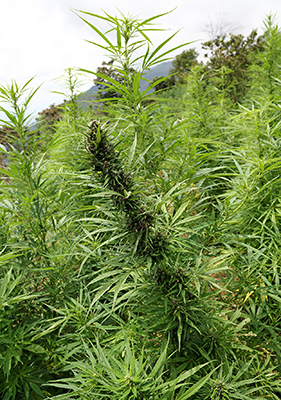
“This is like, once in a hundred years that you just drive in an area and see a bunch plants and just get to [pick the seeds out],” says Arjan looking at the home and then out over the land thoughtfully, “If this plant wasn’t illegal, perhaps there wouldn’t be money to fund these wars.”
Although Arjan and Franco enjoy the best of world culture: foods, music, landscapes and libations, in the most beautiful corners of the planet, their work is not without risk. The impact of the United State’s War on Drugs is global, from the wars and inequality funded by global demand for cannabis as a medicine and a recreation to the real-life consequences of the international laws and violence caused by the unrealistic goal of suppressing that demand.
“When it becomes a [legal] industry, it is because there are serious people like Arjan who can make an impact,” says Franco, “Before that it was just a bunch of hippies getting high.”
Originally published in issue 9 of Cannabis Now. LEARN MORE.
Roll a big joint and watch the whole expedition yourself at strainhunters.com/vice. Subtitles are available in most languages.



